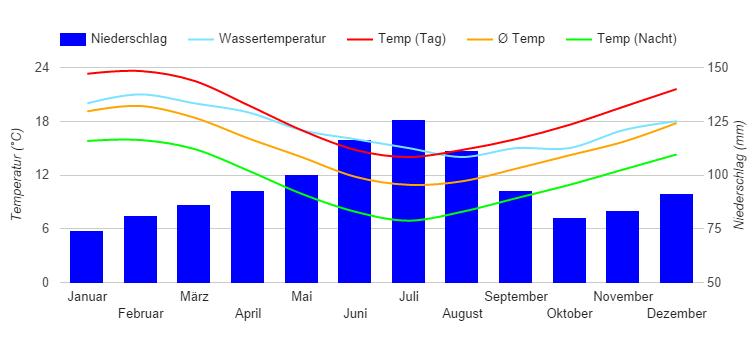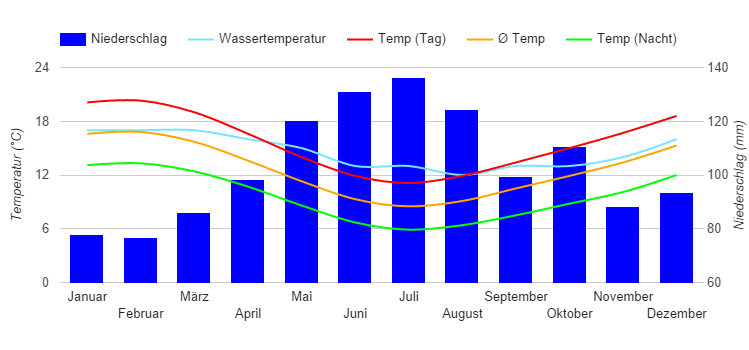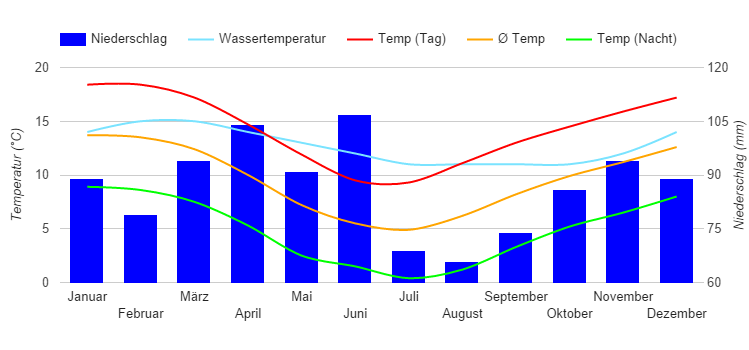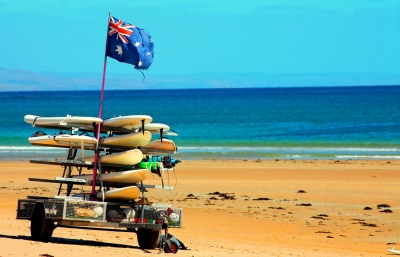![Lake Ruataniwha (Ben) [flickr.com] CC BY-ND
License Information available under 'Proof of Image Sources' Lake Ruataniwha (Ben) [flickr.com] CC BY-ND
License Information available under 'Proof of Image Sources'](/wp-content/uploads/reiseziele/lake-ruataniwha92871.jpg)
Furthermore, we analyzed all climate data and provide a recommendation about which months are best to visit New Zealand for your holiday.
Climate Overview
 0 °C to 24 °C
0 °C to 24 °C 11 °C to 21 °C
11 °C to 21 °C 2.6 – 5.35 in (7 – 16 Days of Rain)
2.6 – 5.35 in (7 – 16 Days of Rain)Average Annual Temperature is between 9.6 °C (Invercargill) and 15.1 °C (Auckland)
Show temperatures in degree
Geographical location
Table of Contents
New Zealand is located in the southern Pacific. The island state consists of a North and a South Island and more than 700 smaller islands.
The 14 miles wide Cook Strait separates the two main islands. New Zealand is 167000 square miles in total.
The Tasman Sea is a marginal sea of the Pacific Ocean that separates New Zealand from Australia, which is up to 1300 miles away. Other neighbouring countries are the French New Caledonia and the South Sea islands of Fiji and Tonga.
The capital of New Zealand is Wellington in the southern part of the North Island. However, Auckland is by far the largest conurbation with around 1.5 million inhabitants.
Climate in New Zealand
 New Zealand has two climate zones. In the north of the northern island there is a subtropical climate characterized by mild winters and relatively warm summers. In the southern part of the North Island and on the entire South Island there is a temperate climate. The further south you go, the lower the temperature. In New Zealand’s coastal areas you will find average annual temperatures of 15 °C in the north and 9 °C in the south.
New Zealand has two climate zones. In the north of the northern island there is a subtropical climate characterized by mild winters and relatively warm summers. In the southern part of the North Island and on the entire South Island there is a temperate climate. The further south you go, the lower the temperature. In New Zealand’s coastal areas you will find average annual temperatures of 15 °C in the north and 9 °C in the south.
The average temperature in January and February in the northern city of Auckland is 20 °C, in Wellington 16 °C and in Dunedin, which lies in the south of the South Island, 15 °C. In July, the average temperature in Auckland is 11 °C, in Wellington 8 °C and in Dunedin 6 °C. July is the coldest month.
The country experiences neither extreme heat nor severe cold with the exception of the high mountain regions. In New Zealand rainfall is relatively even throughout the year. On New Zealand’s North Island, on average, more than 0.04 in fall every year. Up to 314.96 in of rainfall per year falls on the west coast of the South Island. Snow often falls in high altitudes.
On the east side of the South Island, on the other hand, precipitation is sometimes below 29.53 in per year. Most rainfall falls from June to August. The driest months are the summer months from December to February, when the sun shines quite often.
Best Time to Visit New Zealand: Overview
JanuaryJan Best time to traveltime PerfectPerf. climate in New Zealand | FebruaryFeb Best time to traveltime PerfectPerf. climate in New Zealand | MarchMar Best time to traveltime PerfectPerf. climate in New Zealand | AprilApr Good time to traveltime rather wet, but pleasant in overall | MayMay Winteranfang quite cold notably on the south island, a little volatile | JuneJun Winter quite dark, quite cold notably on the south island |
JulyJul Winter Coldest month in New Zealand | AugustAug Winter very cold notably on the south island, but days getting more sunny | SeptemberSep Suitable time to traveltime getting warmer | OctoberOct Good time to traveltime spring taking over, noticeable warmer | NovemberNov Best time to traveltime Start of Summer in New Zealand | DecemberDec Best time to traveltime PerfectPerf. climate in New Zealand |
When to go to New Zealand?
The best time to visit New Zealand is in the summer months between November and March. They are also the high season on both islands and offer ideal conditions for active holidays and sporting activities such as rafting, swimming, diving, surfing or hiking.
Skiers prefer the winter months from June to August. In order to achieve a good compromise between suitable travel weather and a reasonable price level, we recommend the months of October and November as well as February and March. April is also recommended for a New Zealand trip with good off-season offers.
Best Time to Visit the Regions
Find the best time to visit the regions (New Zealand) in the following overview.| Location | Best Time to Travel |
|---|---|
| Auckland | January, February, March, September, October, November, and December |
| Wellington | January, February, March, November, and December |
| Invercargill | January, February, March, November, and December |
Climate Charts New Zealand
In the following, you will find climate charts for the regions.
Furthermore, there are some charts you can use for quick comparison of climate between the regions.
Show Climate Chart for
Auckland

Show temperatures in degree
Source of Data: German Weather Service (Offenbach) and Wikipedia
Climate Tables New Zealand
In the following, you will find some climate tables for New Zealand, containing information about Temperatures, Precipitation, Water Temperatures, and Hours of Sunshine.Show climate table for
Temperatures, Precipitation, Sunshine in Auckland (New Zealand)
| Jan | Feb | Mar | Apr | May | Jun | Jul | Aug | Sep | Oct | Nov | Dec | |
|---|---|---|---|---|---|---|---|---|---|---|---|---|
| Day Temperature | 23° | 24° | 23° | 20° | 17° | 15° | 14° | 15° | 16° | 18° | 20° | 22° |
| Night Temperature | 16° | 16° | 15° | 13° | 10° | 8° | 7° | 8° | 9° | 11° | 13° | 14° |
| Water Temperature | 20° | 21° | 20° | 19° | 17° | 16° | 15° | 14° | 15° | 15° | 17° | 18° |
| Precipitation (inch) | 2.93 | 3.2 | 3.4 | 3.66 | 3.95 | 4.58 | 4.94 | 4.39 | 3.66 | 3.16 | 3.29 | 3.6 |
| Rainy days | 8 | 7 | 8 | 11 | 12 | 15 | 16 | 15 | 13 | 12 | 10 | 9 |
| Hours of Sunshine | 7 | 7 | 6 | 5 | 5 | 4 | 4 | 5 | 5 | 6 | 6 | 6 |
Show temperatures in degree
Temperatures
The annual average temperature in Auckland is 15.1 °C.For comparison: London 11 °C, NYC 12 °C, LA 17.9 °C
Warmest month: February (19.7 °C)
Coldest month: July (10.9 °C)
The maximum water temperature in Auckland is 21 °C. You can take a bath at these temperatures.
Months with water temperature of at least 17 °C (Limited bathing is possible):
January, February, March, April, May, November, and December
Months with water temperature of at least 21 °C (adequate for beach vacation):
February
Precipitation
Overall annual precipitation: 44.75 inch on 136 rainy daysFor comparison: London 24.06 in, NYC 41.57 in, LA 12.01 in
There is no rainy season (months with more than 6.9 in of precipitation).
You cannot expect snow in any month in Auckland.
Sunshine
As our climate table shows, January is the sunniest month with an average of 7.4 hours of sunshine per day. Over the year, there are 5.5 hours of sunshine per day on average. For comparison: London has 4.1, NYC has 7 and LA has 8.9 hours of sunshine per day on average.Temperatures, Precipitation, Sunshine in Wellington (New Zealand)
| Jan | Feb | Mar | Apr | May | Jun | Jul | Aug | Sep | Oct | Nov | Dec | |
|---|---|---|---|---|---|---|---|---|---|---|---|---|
| Day Temperature | 20° | 20° | 19° | 17° | 14° | 12° | 11° | 12° | 13° | 15° | 17° | 19° |
| Night Temperature | 13° | 13° | 12° | 11° | 9° | 7° | 6° | 6° | 8° | 9° | 10° | 12° |
| Water Temperature | 17° | 17° | 17° | 16° | 15° | 13° | 13° | 12° | 13° | 13° | 14° | 16° |
| Precipitation (inch) | 3.06 | 3.03 | 3.39 | 3.87 | 4.74 | 5.17 | 5.37 | 4.9 | 3.92 | 4.36 | 3.48 | 3.68 |
| Rainy days | 7 | 7 | 8 | 9 | 12 | 13 | 13 | 13 | 11 | 12 | 9 | 9 |
| Hours of Sunshine | 8 | 7 | 6 | 5 | 4 | 3 | 4 | 4 | 5 | 6 | 7 | 7 |
Show temperatures in degree
Temperatures
The annual average temperature in Wellington is 12.7 °C.Warmest month: February (16.8 °C)
Coldest month: July (8.5 °C)
The maximum water temperature in Wellington is 17 °C. Comfortable bathing is possible at water temperatures of about 21 °C.
Months with water temperature of at least 17 °C (Limited bathing is possible):
January, February, and March
Precipitation
Overall annual precipitation: 48.96 inch on 123 rainy daysThere is no rainy season (months with more than 6.9 in of precipitation).
You cannot expect snow in any month in Wellington.
Sunshine
As our climate table shows, January is the sunniest month with an average of 7.8 hours of sunshine per day. Over the year, there are 5.7 hours of sunshine per day on average.Temperatures, Precipitation, Sunshine in Invercargill (New Zealand)
| Jan | Feb | Mar | Apr | May | Jun | Jul | Aug | Sep | Oct | Nov | Dec | |
|---|---|---|---|---|---|---|---|---|---|---|---|---|
| Day Temperature | 18° | 18° | 17° | 15° | 12° | 10° | 9° | 11° | 13° | 15° | 16° | 17° |
| Night Temperature | 9° | 9° | 8° | 5° | 3° | 2° | 0° | 1° | 3° | 5° | 7° | 8° |
| Water Temperature | 14° | 15° | 15° | 14° | 13° | 12° | 11° | 11° | 11° | 11° | 12° | 14° |
| Precipitation (inch) | 3.5 | 3.11 | 3.7 | 4.09 | 3.58 | 4.21 | 2.72 | 2.6 | 2.91 | 3.39 | 3.7 | 3.5 |
| Hours of Sunshine | 6 | 6 | 4 | 3 | 3 | 2 | 3 | 4 | 5 | 5 | 6 | 6 |
Show temperatures in degree
Temperatures
The annual average temperature in Invercargill is 9.6 °C.Warmest month: January (13.7 °C)
Coldest month: July (4.9 °C)
The maximum water temperature in Invercargill is 15 °C. Bathing would be very uncomfortable.
Precipitation
Overall annual precipitation: 41.02 inchThere is no rainy season (months with more than 6.9 in of precipitation).
Months that have possible snowfall: May, June, July, August, and September
Sunshine
As our climate table shows, December is the sunniest month with an average of 5.9 hours of sunshine per day. Over the year, there are 4.4 hours of sunshine per day on average.Highlights and Attractions
One of New Zealand’s most popular destinations is Milford Sound, a fjord in the Fjordland National Park, which is also a UNESCO World Heritage Site. You should also visit Queenstown, Dunedin and Auckland. Fascinating landscapes await you at the Bay of Islandys and Hawke’s Bay.
Popular Activities
From Auckland: Hobbiton & Waitomo Caves Day Trip with Lunch
Tours
from 211 $ »
Set off on an adventure from Auckland to see New Zealand’s two most famous attractions in one day: the Hobbiton movie sett and the Waitomo Glowworm Caves.
Waiheke Island: Ferry & Hop-On Hop-Off Explorer Bus Tickets
Nature & Panorama
from 48 $ »
Expereince the beauty of Waiheke Island on a ferry ride from Auckland. See the local sights with a hop-on hop-off bus tour to 16 destinations like the Mudbrick Vineyard and the Cable Bay Vineyard.
Auckland: Whale and Dolphin Watching Half-Day Eco Cruise
Tours
from 106 $ »
Experience Hauraki Gulf Marine Park on a 4.5-hour marine eco-safari. Enjoy a guarantee where if you don’ts see any marine mammals, you can take the cruise again for free.
More attractions
Auckland: Hobbiton & Waitomo Bus Tour with Festive Lunch | Auckland: Hop-On Hop-Off Explorer Bus Ticket | Auckland: Shuttle Between Airport & City CBD | From Auckland: Hobbiton, Rotorua & Waitomo Caves Day Trip | Auckland: Hobbiton Movie Set and Waitomo Small Group Tour | Auckland: Waiheke Island Fast Ferry Pass | Sea Life Kelly Tarlton’s Aquarium General Admission |Current Weather and Forecast
Current Weather in Auckland (Station Western Springs)
Clouds: 75 % Wind: 10 mph SSW
Air Pressure: 1009 hPa Humidity: 70 %
Air Pressure: 1009 hPa Humidity: 70 %
Last updated: 7th Feb 2023, 10:44 am
The next days …
| 8th Feb 2023 | 9th Feb 2023 | 10th Feb 2023 | 11th Feb 2023 | 12th Feb 2023 | 13th Feb 2023 |
|---|---|---|---|---|---|
| 17 °C to 23 °C | 17 °C to 20 °C | 16 °C to 22 °C | 17 °C to 22 °C | 18 °C to 19 °C | 17 °C to 20 °C |
| Clouds: 78 % | Clouds: 67 % | Clouds: 39 % | Clouds: 98 % | Clouds: 100 % | Clouds: 100 % |
| 0.01 in of rain | No Precipitation | 0.02 in of rain | 0.15 in of rain | 0.22 in of rain | 4.72 in of rain |
Weather information provided by OpenWeatherMap. (CC BY-SA)
Show temperatures in degree
Share your Experience and Win
We want to know: how was the weather during your New Zealand holiday? You can win a travel coupon of 1000 $. The price will be raffled among all submissions.





 February:
February:  July:
July:  August:
August: ![Mt.Cook (lwtt93) [flickr.com] CC BY
License Information available under 'Proof of Image Sources'](/wp-content/uploads/reiseziele/mtcook2417_preview.jpg)
![Queenstown (Rajeev Rajagopalan) [flickr.com] CC BY
License Information available under 'Proof of Image Sources'](/wp-content/uploads/reiseziele/queenstown2757_preview.jpg)
![(Jocelyn Kinghorn) [flickr.com] CC BY-SA
License Information available under 'Proof of Image Sources'](/wp-content/uploads/reiseziele/95466_preview.jpg)






New Zealand: Experiences of our Visitors
We spent 4 weeks in November and December in New Zealand and had both hot, very sunny days and heavy rain. Maximum temperature was 32 degrees, minimum was 6 degrees.
Weather Rating: 3 stars – Mixed